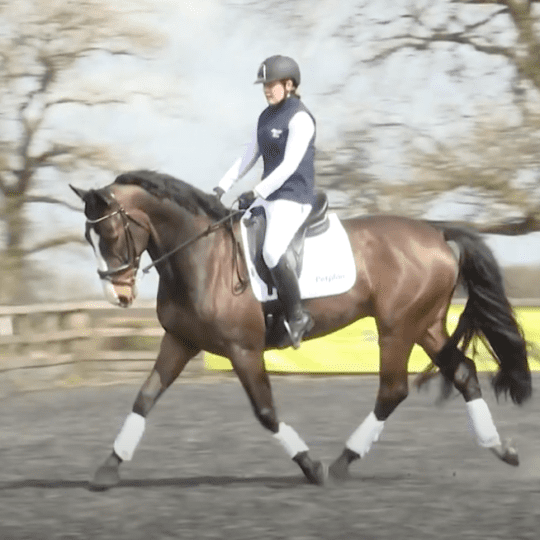Five exercises to try this week
Posted in Flatwork Riding Schooling and Training Jumping Hacking Groundwork and Handling
From in-hand work to athletic jumping, we’ve got five quick and easy exercises for you to try this week that you can work through with less than 30 minutes on the clock

1. Collect on a circle
Why do it? Establishing and developing a lower gear within your horse’s gaits is invaluable. Whether it’s for smooth, powerful transitions, adjusting him to make a distance or turn while jumping or to work towards more advanced dressage movements, it’s important no matter your discipline. Working on collection also improves your horse’s muscle tone, refines his halt-halt response and encourages him to engage his hindquarters.
How to ride it Beginning in trot, establish a working pace on a 20m circle. When your horse feels soft and rhythmical, take a half-halt and slow your rising – tightening your core, keeping your upper body tall and your weight in your heels will help you balance – closing your legs gently around his sides to maintain the energy. Try and maintain an even feel in the contact, pushing him forward if he ducks behind it and sponging your inside rein if he comes above the bit. Once he’s offered you a few shortened steps, praise him, push him forward into a working pace for half a circle or so and repeat, changing the rein frequently
Step it up When you feel ready to progress, try the exercise in canter. Minus the rising, the aids are just the same as in trot and you’ll know you’ve got it right when it feels as if your horse is sitting back on his hocks.
2.Trot–halt hacking
Why do it? Good trot-halt transitions are essential for your dressage training but, when performed correctly, they’re also a fantastic way lighten your horse’s forehand and test the effectiveness of your half-halt aids. If you’re someone who tends to canter and trot in the same places on each hack, practising some simple straight-line schooling is a great way to test your control and his attentiveness.
How to ride it The best setting for this exercise is a long, straight bridleway. Pick up an active working trot and look to feel an even, comfortable weight in each rein. Half-halt to collect your horse and prepare him for the transition. Then, without taking off your leg completely, sit tall and deep in the saddle with your core tight and your pelvis still. Close your hands on the reins to start with but be careful that you horse doesn’t resist the pressure. It might be that you need to practise more progressive transitions with a soft hand initially, focusing on stilling your seat, until your horse is able to accept and maintain the contact through the downward transition. Once he’s halted and immobile, praise him, walk on and repeat.
Step it up Ask for a direct upward transition back up to trot from halt – intersperse them with halt–walk transitions, though, otherwise your horse may begin to anticipate.
3. In-hand walk poles
Why do it? When you’re short on time, daylight and the energy to ride, in-hand polework is a relaxing bonding exercise with great muscle-building benefits – a bit like equine squats.
How to do it Set up a line of at least four poles on a 0.8–1m walking distance – if your horse is fit and familiar with polework, you can add as many more as you feel is appropriate. Using a long rope or lunge line, give your horse a walk to loosen off for a few minutes, changing the rein halfway through, and then approach the poles. Aim for an active yet unhurried walk and allow him to lower his head as he reaches the poles – not just to process the exercise, but also to activate his core and the muscles adjacent to his spine. Ideally, he’ll walk through the middle of the poles while you walk on the outside of them at his shoulder – it might be helpful to carry a schooling whip to push him towards the centre and keep his walk active.
Step it up Use pole pods to gradually raise the poles one by one. You could build on the number you raise in each session, but always start with flat poles.
4. Punchy medium trot
Why do it? This is where the collection you worked on in exercise one comes into play and can be used to help unlock medium trot strides. It tests your horse’s response to your leg aids and helps you refine his medium trot for Novice dressage tests and above.
How to ride it Establish working trot and use your collection skills to ride a 10-12m circle in the corner of your arena. As you come out of the circle and approach the long side, apply your leg, allow slightly with your hands and increase the length of your rise, holding yourself out of the saddle for longer. If you’ve got it right, your horse’s strides will feel longer and more energised, but the feeling in the contact will remain the same.
Step it up When you’ve come out of the circle, ask for the medium strides along the long diagonal to test your horse’s straightness.

5. Offset treble
Why do it? As well as a great cardiovascular exercise for your horse, the offset treble is fantastic to use both as a jump or cavaletti exercise. Use it to test how well you can maintain a rhythm, practise changes of lead, work on suppleness and even straightness. It involves three fences on a bounce (3.5–4m) or one-stride (7.5m) distance, or cavaletti on a canter stride distance (3m) in an offset line.
How to ride it There are two uses for this exercise, so why not leave it up in the arena and get two sessions out of it?
Circles – Approach the first pole in the sequence, aiming for the middle. You’ll be changing the rein over the pole, which will entail a change of direction if you’re trotting and a change of lead if you’re in canter. Before you reach the pole, look in the new direction and open your new inside hand slightly to encourage bend. If you’re cantering, apply the new canter aid over the pole. Circle round and repeat over the next pole. If the poles are set on a bounce distance, you’ll have to circle back round the first fence rather than cut between.
Straight – Ride straight through the line, which means you’ll have to ride a line that takes you tight to the jump wings on each fence. Ensure you ride both sides of your horse’s body evenly and keep him between your leg hand to stay in control of his straightness. Keep the fences as poles or very low uprights to begin with, raising them if you feel comfortable.


















